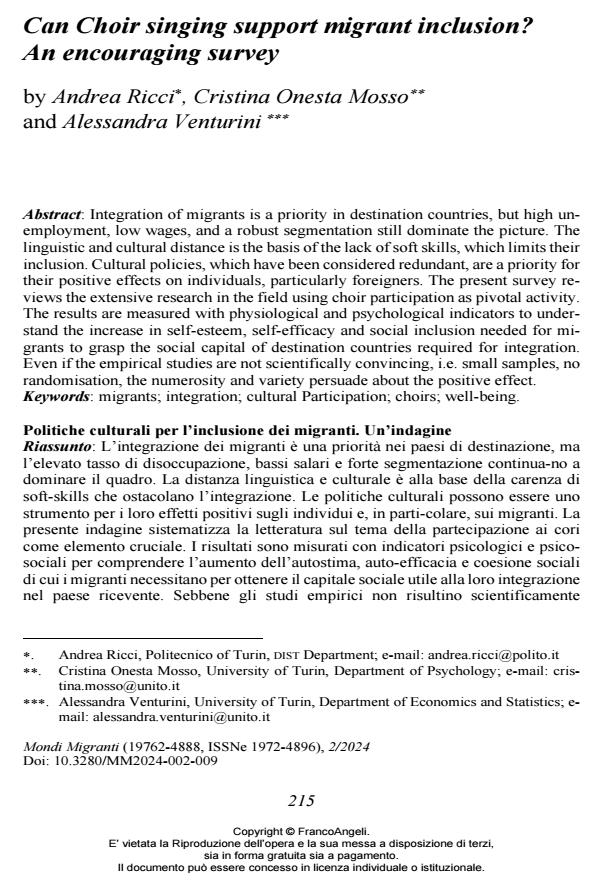Can Choir singing support migrant inclusion? An encouraging survey
Titolo Rivista MONDI MIGRANTI
Autori/Curatori Andrea Ricci, Cristina Onesta Mosso, Alessandra Venturini
Anno di pubblicazione 2024 Fascicolo 2024/2
Lingua Inglese Numero pagine 23 P. 215-237 Dimensione file 250 KB
DOI 10.3280/MM2024-002009
Il DOI è il codice a barre della proprietà intellettuale: per saperne di più
clicca qui
Qui sotto puoi vedere in anteprima la prima pagina di questo articolo.
Se questo articolo ti interessa, lo puoi acquistare (e scaricare in formato pdf) seguendo le facili indicazioni per acquistare il download credit. Acquista Download Credits per scaricare questo Articolo in formato PDF

FrancoAngeli è membro della Publishers International Linking Association, Inc (PILA)associazione indipendente e non profit per facilitare (attraverso i servizi tecnologici implementati da CrossRef.org) l’accesso degli studiosi ai contenuti digitali nelle pubblicazioni professionali e scientifiche
During the Covid-19 pandemic, Italy imposed lockdown measures, which also affected places of worship that had to suspend group religious celebrations. This study focuses on the dematerialization of the sacred space, achieved through the creation of the “digital mosque.” The author interviewed imams and participated in online worship during the lockdown. The analysis of the data explored various facets, including the reactions of Muslim communities to the impact of the lockdown and government directives guidelines. The study then delved into the transition of certain communities from offline Islam to online Islam, culminating in the establishment of the “digital mosque.” The lat-ter serves as both a virtual gathering place for the faithful and a tool for social control and the definition of authority in the interpretation of the online inter-pretation of the sacred. However, it should be noted that different Muslim communities reacted in various ways to the use of the internet.
Durante la pandemia di Covid-19, l’Italia ha imposto il confinamento, coin-volgendo i luoghi di culto che hanno dovuto sospendere le celebrazioni reli-giose di gruppo. Questo studio si concentra sulla de-materializzazione del luo-go sacro, attraverso la creazione della “moschea digitale”. L’autore ha intervi-stato imam e partecipato a culti online durante il lockdown. L’analisi dei dati ha esaminato diverse sfaccettature, comprese le reazioni delle comunità mu-sulmane all'impatto del lockdown e alle direttive governative. Lo studio ha poi esplorato la transizione di alcune comunità dall’islam offline all’islam online, concludendo nella formazione della “moschea digitale”. Quest’ultima è sia un luogo virtuale di incontro per i fedeli sia uno strumento per il controllo sociale e la definizione dell’autorità nella interpretazione del sacro online. Va co-munque notato che le diverse comunità musulmane italiane hanno reagito in modi vari all’uso di internet come mezzo per celebrare i riti.
Parole chiave:Islam; Covid-19; sociologia; moschea; digitalizzazione.
Andrea Ricci, Cristina Onesta Mosso, Alessandra Venturini, Can Choir singing support migrant inclusion? An encouraging survey in "MONDI MIGRANTI" 2/2024, pp 215-237, DOI: 10.3280/MM2024-002009